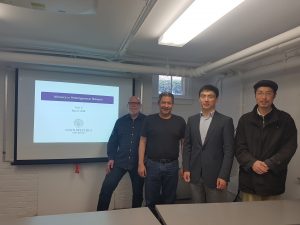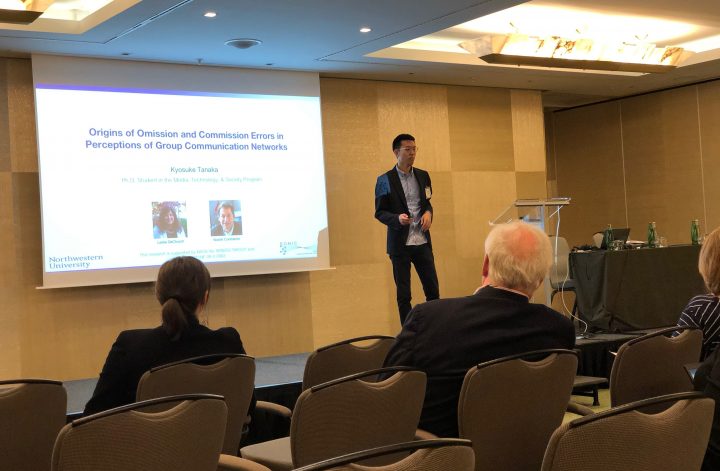A recent research from West Virginia University shows how to detect opioid addicted people from large structured heterogeneous networks using transductive learning. Check out the paper: https://dl.acm.org/citation.cfm?id=3132857
Noshir Contractor presents at ICA 2018
Noshir Contractor presents a paper (co-authored with Michael Schultz and Leslie DeChurch) titled “Communicating through space and over time” at ICA 2018, in Prague, Czech Republic.

Schultz, M., DeChurch, L., & Contractor, N. (2018, May). Communicating through space and over time. Paper to be presented at the 68th Annual ICA conference, “Voices,” Prague, Czech Republic.
Noshir Contractor and Kyosuke Tanaka presented their research at #ICA2018
Noshir Contractor and Kyosuke Tanaka presented their research at the 68th Annual Conference of International Communication Association in Prague, the Czech Republic:
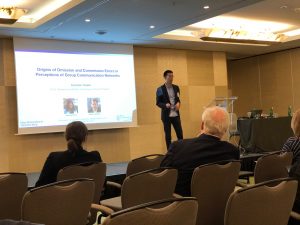
- Tanaka, K., DeChurch, L., & Contractor, N. (2018, May). Origins of omission and commission errors in perceptions of group communication networks. Paper to be presented at the 68th Annual ICA conference, “Voices,” Prague, Czech Republic.
- Schultz, M., DeChurch, L., & Contractor, N. (2018, May). Communicating through space and over time. Paper to be presented at the 68th Annual ICA conference, “Voices,” Prague, Czech Republic.
Noshir Contractor presents at the Computational Social Science Luncheon
Noshir Contractor’s presentation at the Computational Social Science Luncheon at Northwestern University on May 21, 2018 was titled “Some Assembly Required: Teaming in the 21st Century”.
Modeling the diffusion of complex innovations as a process of opinion formation through social networks
A new research article by Valentina Assenova demonstrates how innovations diffuse through networks. Her model incorporates opinion formation processes that occur through diffusion. She also tested her model with diffusion data from a field experiment previously collected in India (Banerjee et al., 2013).
The research article is published in PLoS One: http://journals.plos.org/plosone/article?id=10.1371/journal.pone.0196699
A podcast about the article is here: http://knowledge.wharton.upenn.edu/article/can-innovation-spread-faster-through-social-networks/
Reference:
Banerjee A, Chandrasekhar AG, Duflo E, Jackson MO. The Diffusion of Microfinance. Science. 2013;341(6144):1236498. pmid:23888042
SONIC Speaker Series presents: Prasad Balkundi
The SONIC Speaker Series presents
Prasad Balkundi
Organization and Human Resources, University of Buffalo
The Negative Side of the Social Ledger: A Meta-Analysis
SONIC Lab is proud to welcome Prasad Balkundi of the University of Buffalo. Dr. Balkundi will speak on Wednesday, April 18th, 2017 at 10 AM in Frances Searle Building, Room 1-483. Please contact Dr. Michael Schultz with any questions.
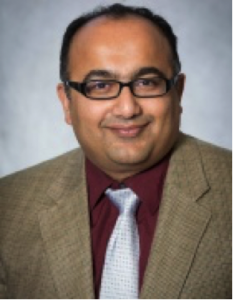
Abstract:
Despite a resurgence of research on negative ties in social networks, a comprehensive understanding of negative and positive has yet to be provided. Incorporating evidence from prior 163 independent samples we examine whether the initiation of positive and negative relationships (i.e., out-degree) or the reception of positive and negative relationships (i.e., in-degree) is more impactful to the focal employee’s effectiveness. Furthermore, to address the negative asymmetry hypothesis in social networks, we compare the relative importance of positive versus negative work relationships while holding the directionality constant. This meta-analytic review makes five contributions to theory on negative and positive social networks by (a) demonstrating the undermining impact of negative ties on performance and job attitudes; (b) providing information on the negative asymmetry hypothesis within social networks to reveal that negative ties occur less frequently than positive ties and that any asymmetry effects depend on the relative number of negative ties to positive ties in the context; (d) distinguishing between haters (senders of negative ties) and jerks (receivers of negative ties) to illustrate that haters have worse job attitudes than jerks, but the two do not differ on performance; and (e) providing positive and negative affect as antecedents to negative ties. Implications of these findings along with study limitations and future research directions are discussed.
Prasad Balkundi is Chair and Associate Professor in the Organization and Human Resources Department at the University of Buffalo School of Management. Prof. Balkundi’s teaching and research interests are in social networks and team processes. He has published in the Academy of Management Journal and Leadership Quarterly. He is active in the Academy of Management National Conference and has presented several papers over the years.
Stream the talk here:
SONIC Speaker Series presents: Gianluca Carnabuci
The SONIC Speaker Series presents
Gianluca Carnabuci
Organizational Behavior, ESMT Berlin
Good For One But Bad For Most? How Intra-Organizational Networks Impact Innovative Performance At The Inventor And Firm Level
SONIC Lab is proud to welcome Gianluca Carnabuci of ESMT Berlin. Dr. Carnabuci will speak on Wednesday, April 26th, 2017 at 10 AM in Frances Searle Building, Room 1-483. Please contact Dr. Michael Schultz with any questions.

Abstract:
Extant organizational research suggests that R&D scientists tend to be more productive (i.e., they generate more impactful innovations) when they occupy a central position within their organization’s intra-organizational collaboration network. Does this imply that an organization’s overall innovative performance would increase if the organization encouraged its R&D scientists to pursue more central network positions? We address this question using a multi-level panel dataset describing the evolving intra-organizational networks of 140 semiconductor firms, as well as the individual network position of each of their R&D scientists. We proceed in three steps. First, we confirm that network centrality does enhance scientists’ innovative performance within our empirical sample, even after controlling for unobserved individual- and organizational-level differences. Second, we simulate how the overall intra-organizational network of an organization would change if it enacted two distinct norms of collaboration, each encouraging scientists to increase their network centrality. We find that norms of “diffuse” collaboration increase network cohesion, whereas “star-centric” ones increase network centralization. Third, we study how these network-level properties affect innovative performance among our semiconductor firms. We find that network cohesion enhances organizational-level innovative performance only under conditions of high knowledge diversity, while network centralization always reduces it. These findings show that scientists’ pursuit of network centrality may have opposite performance effects at the individual- and organizational-level. A counterintuitive normative implication is that, under quite broad conditions, organizations would enhance their innovative performance by discouraging (rather than encouraging) their R&D personnel from increasing their centrality within the intra-organizational network.
Gianluca Carnabuci is an associate professor (with tenure) of organizational behavior who joined ESMT Berlin in broad conditions, organizations would enhance their innovative performance b 2016. Previously he was an associate professor of organization and management at the University of Lugano and an assistant professor at Bocconi University. He holds a PhD in Social and Behavioral Sciences from the University of Amsterdam.
Stream the talk here:
SONIC Speaker Series Presents: Sadat Shami
The SONIC Speaker Series presents
N. Sadat Shami
Director, Center for Engagement and Social Analytics IBM
The Application of Social Analytics to Understand and Improve Organizational Outcomes
SONIC Lab is proud to welcome N. Sadat Shami of IBM. Dr. Shami will speak on Monday, February 26th, 2017 at 10 AM in Frances Searle Building, Room 1-483. Please contact Dr. Michael Schultz with any questions.

Abstract:
The increased adoption of social media in the enterprise provides an opportunity for organizations to receive real-time feedback from employees on organizational issues. Enterprise social media provides a platform for employees to express their thoughts and opinions on organizational programs, policies, and strategies through unstructured text in status updates, blogs, online community forums etc. Such textual data can be mined to generate insights about the employee experience. Research has shown that organizations that take into consideration employee feedback in organizational decision-making are more productive, and have employees that are more engaged with the organization. In this talk, he will first describe the design and use of Social Pulse – a tool to make sense of large- scale social media text generated by employees of an organization while preserving privacy. He will then describe how social media text mined by Social Pulse, combined with an organization’s hierarchical network structure can be used in statistical models to predict outcomes of interest to an organization, focusing on the particular case of employee engagement, and how it spreads in an organization.
N. Sadat Shami leads Talent Development, Engagement and Social Analytics for IBM. He has responsibility for analytics, insights and strategy around leadership, learning, inclusion, employee engagement and IBMer social media. His team of researchers and practitioners focus on enabling better business decisions by applying AI techniques on large-scale social media, social network, and enterprise data. He has led several advanced analytics projects in the employee engagement and social space, showing linkage with various outcomes of interest to IBM. Sadat has a PhD in Information Science from Cornell University, has published over 20 articles in highly selective peer-reviewed conferences and journals, and has lived in five countries.
Stream the talk here:
SONIC Speaker Series presents: Johan Ugander
The SONIC Speaker Series presents
Johan Ugander
Management Science & Engineering Stanford University
Ruffled Feathers: Trait inference beyond homophily
SONIC Lab is proud to welcome Johan Ugander of Stanford University. Dr. Ugander will speak on Tuesday, February 6th, 2017 at 10 AM in Frances Searle Building, Room 1-483. Please contact Dr. Michael Schultz with any questions.
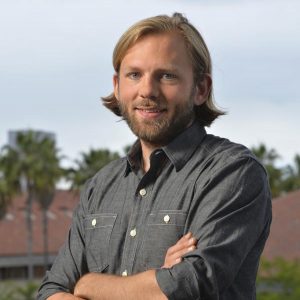
Abstract:
The observation that individuals tend to be friends with people who are similar to themselves, commonly known as homophily, is a prominent and well-studied feature of social networks. While homophily describes a bias in attribute preferences for similar others, it gives limited attention to variability. In this work, we observe that attribute preferences can exhibit variation beyond what can be explained by models of homophily. We call this excess variation monophily to describe the presence of individuals with extreme preferences for a particular attribute possibly unrelated to their own attribute. We observe that monophily can induce a similarity among friends-of-friends on a network without requiring any similarity among friends. In order to independently simulate homophily and monophily in synthetic networks, we contribute a new model of social network structure that we call the overdispersed stochastic block model (oSBM), an extension of the classical stochastic block model. We use this model to demonstrate how homophily-based methods for predicting attributes on social networks based on friends, “the company you keep,” are fundamentally different from monophily-based methods based on friends- of-friends, “the company you’re kept in.” To illustrate the differences between homophily and monophily-based prediction we place particular focus on predicting gender, where homophily can be weak or nonexistent in practice. These findings offer an alternative perspective on network structure and attributes in general and prediction in particular, complicating the already difficult task of protecting privacy on social networks. This is joint work with Kristen Altenburger.
Johan Ugander is an Assistant Professor at Stanford University in the Department of Management Science & Engineering, within the School of Engineering. His research develops algorithmic and statistical frameworks for analyzing social networks, social systems, and other large-scale social data.
Stream the talk here:
Yuan Li successfully defends dissertation on leveraging meta data and topology to infer the role that a node plays in the network
Yuan successfully defended his dissertation titled “Inference in heterogeneous network”. His research leverages meta data, namely node attributes and dyadic attribute, and topology to infer the role that a node plays in the network. His committee consisted of Noshir Contractor, Wenxin Jiang, and Bruce Spencer. Upon graduating with a PhD in Statistics, Yuan will work at Google’s Search Team as a Data Scientist.
